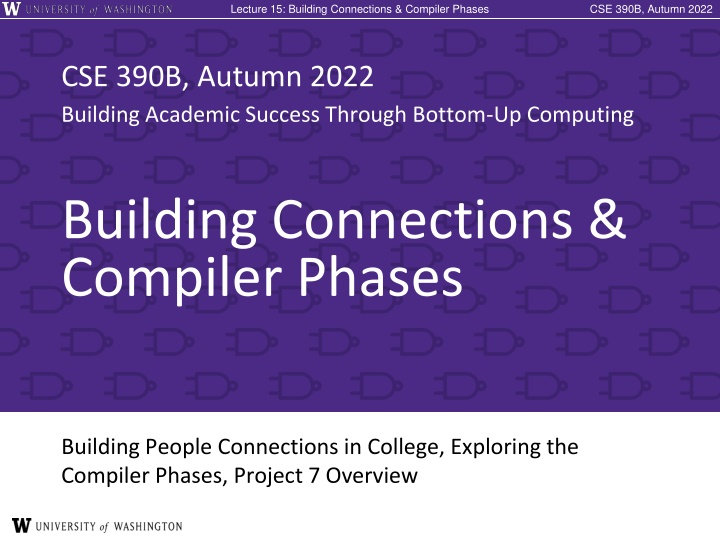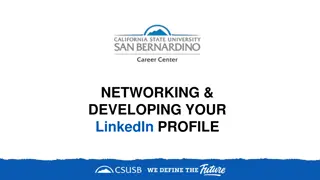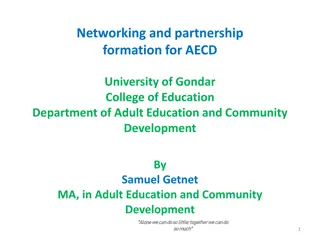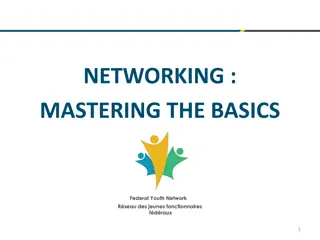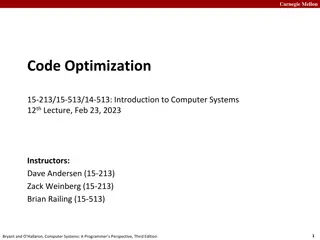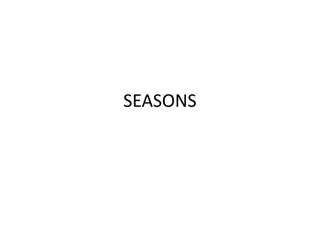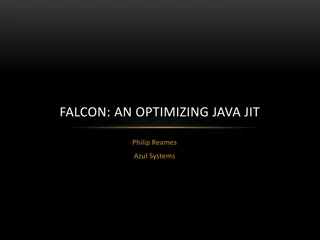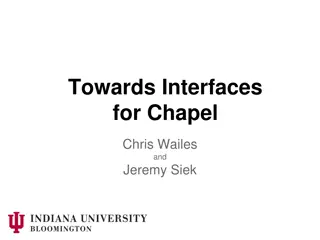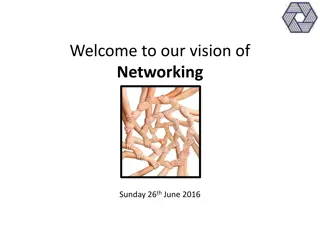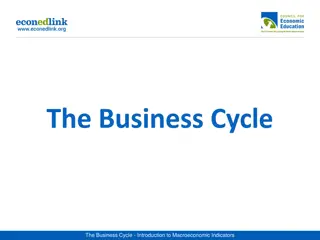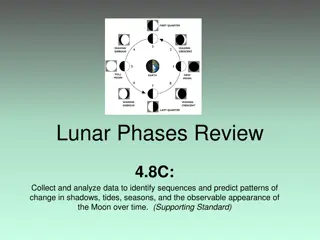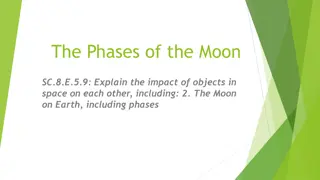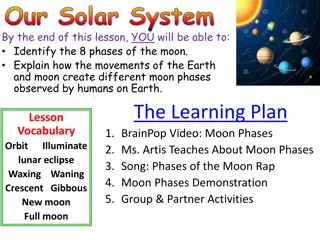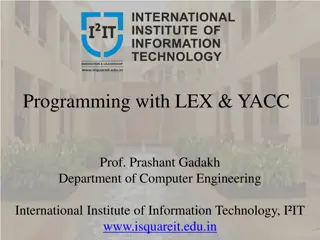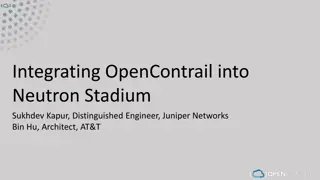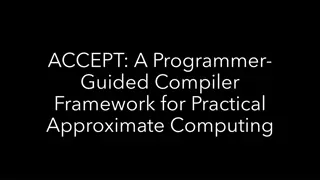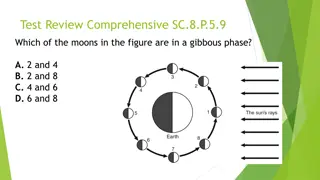Building Connections and Compiler Phases in College: Networking Strategies
Discover the benefits of building connections in college through networking strategies like reaching out to professors, TAs, and peers. Learn the importance of networking, ways to get involved on campus, and how to leverage your connections for personal and academic growth.
Download Presentation

Please find below an Image/Link to download the presentation.
The content on the website is provided AS IS for your information and personal use only. It may not be sold, licensed, or shared on other websites without obtaining consent from the author.If you encounter any issues during the download, it is possible that the publisher has removed the file from their server.
You are allowed to download the files provided on this website for personal or commercial use, subject to the condition that they are used lawfully. All files are the property of their respective owners.
The content on the website is provided AS IS for your information and personal use only. It may not be sold, licensed, or shared on other websites without obtaining consent from the author.
E N D
Presentation Transcript
Lecture 15: Building Connections & Compiler Phases Lecture 15: Building Connections & Compiler Phases CSE 390B, Autumn 2022 CSE 390B, Autumn 2022 CSE 390B, Autumn 2022 Building Academic Success Through Bottom-Up Computing Building Connections & Compiler Phases Building People Connections in College, Exploring the Compiler Phases, Project 7 Overview
Lecture 15: Building Connections & Compiler Phases CSE 390B, Autumn 2022 Lecture Outline Building People Connections in College Benefits of Building Connections, Networking Strategies Exploring the Compiler Phases Scanner: Process of Tokenizing an Input File Parser: Making Meaning From Tokens Through ASTs Type Checking, Optimization, and Code Generation Project 7 Overview Midterm Corrections, Professor Meeting Report 2
Lecture 15: Building Connections & Compiler Phases CSE 390B, Autumn 2022 Benefits of Building Connections Reaching out to your professors, TAs, and peers can be a great way to discover opportunities Taking the time to connect with these people can open several doors and leverage your potential Excellent opportunity for new perspectives and ideas for those who have been in your shoes before Connecting with others helps you find inspiration and build your knowledge and experience 3
Lecture 15: Building Connections & Compiler Phases CSE 390B, Autumn 2022 Strategies for Networking Get involved in communities on campus (e.g., RSOs, TAing, research, part-time campus job) Invest in building relationships with people and developing a presence in their lives Take time to reflect on how others can support you by bringing to them your interests and questions Not all networking efforts will be well-received, but don t be afraid to just go for it 4
Lecture 15: Building Connections & Compiler Phases CSE 390B, Autumn 2022 Discussion on Building Connections In groups, spend 4-6 minutes discussing these questions: In what ways do you already connection with others on a regular basis? How else can you build your connections? How can you benefit from building your community of people you can network with? What would you share with someone you recently made a connection with? 5
Lecture 15: Building Connections & Compiler Phases CSE 390B, Autumn 2022 Lecture Outline Building People Connections in College Benefits of Building Connections, Networking Strategies Exploring the Compiler Phases Scanner: Process of Tokenizing an Input File Parser: Making Meaning From Tokens Through ASTs Type Checking, Optimization, and Code Generation Project 7 Overview Midterm Corrections, Professor Meeting Report 6
Lecture 15: Building Connections & Compiler Phases CSE 390B, Autumn 2022 The Scanner FUNCTION VOID ID(main) LPAREN RPAREN LCURLY VAR function void main() { var int a, bar; let bar=10; // init } INT ID(a) COMMA ID(bar) LET SEMICOLON ID(bar) Jack EQUALS NUM(10) SEMICOLON RCURLY Scanner Token Stream Reads a giant string, breaks down into tokens Each token has a type: what role does this token play? E.g., is a type representing an occurrence of { What types do we care about? The building blocks of our programming language: Keywords (e.g., ), operators (e.g., ), and punctuation (e.g., or ) LCURLY EQUALS FUNCTION SEMICOLON COMMA 7
Lecture 15: Building Connections & Compiler Phases CSE 390B, Autumn 2022 The Scanner FUNCTION VOID ID(main) LPAREN RPAREN LCURLY VAR function void main() { var int a, bar; let bar=10; // init } INT ID(a) COMMA ID(bar) LET SEMICOLON ID(bar) Jack EQUALS NUM(10) SEMICOLON RCURLY Scanner Token Stream In addition to a type, some tokens carry a value: Identifiers (e.g., ) Numbers (e.g., ) Scanner should present a clean token stream No whitespace or comments: the rest of the compiler only wants to consider things that change program meaning ID(a) NUM(10) 8
Lecture 15: Building Connections & Compiler Phases CSE 390B, Autumn 2022 The Scanner: How? FUNCTION VOID ID(main) LPAREN RPAREN LCURLY VAR function void main() { var int a, bar; let bar=10; // init } INT ID(a) COMMA ID(bar) LET SEMICOLON ID(bar) Jack EQUALS NUM(10) SEMICOLON RCURLY Scanner Token Stream What if we split the input program on whitespace, and match each segment to a token type? (E.g., { LCURLY) Tempting, but we would end up with a, bar; bar=10; Whitespace is tricky: generally, we want to ignore it, but we can t count on it being there 9
Lecture 15: Building Connections & Compiler Phases CSE 390B, Autumn 2022 The Scanner: How? curr ; let bar=10; Jack Accumulated: ; Token Stream How to distinguish built-in keywords (e.g., let ) from identifiers (e.g., bar )? When token is done, check against list of keywords 10
Lecture 15: Building Connections & Compiler Phases CSE 390B, Autumn 2022 The Scanner: How? curr ; let bar=10; Jack Accumulated: ; Token Stream How can we take a line of code in Jack and convert this into a token stream? Keep cursor on current char Break off a token when we complete one If the next char could be part of this token, accumulate it 11
Lecture 15: Building Connections & Compiler Phases CSE 390B, Autumn 2022 The Scanner: How? SEMICOLON curr ; let bar=10; Jack Accumulated: Token Stream How can we take a line of code in Jack and convert this into a token stream? Keep cursor on current char Break off a token when we complete one If the next char could be part of this token, accumulate it 12
Lecture 15: Building Connections & Compiler Phases CSE 390B, Autumn 2022 The Scanner: How? SEMICOLON curr ; let bar=10; Jack Accumulated: l Token Stream How can we take a line of code in Jack and convert this into a token stream? Keep cursor on current char Break off a token when we complete one If the next char could be part of this token, accumulate it 13
Lecture 15: Building Connections & Compiler Phases CSE 390B, Autumn 2022 The Scanner: How? SEMICOLON curr ; let bar=10; Jack Accumulated: le Token Stream How can we take a line of code in Jack and convert this into a token stream? Keep cursor on current char Break off a token when we complete one If the next char could be part of this token, accumulate it 14
Lecture 15: Building Connections & Compiler Phases CSE 390B, Autumn 2022 The Scanner: How? SEMICOLON curr ; let bar=10; Jack Accumulated: let Token Stream How can we take a line of code in Jack and convert this into a token stream? Keep cursor on current char Break off a token when we complete one If the next char could be part of this token, accumulate it 15
Lecture 15: Building Connections & Compiler Phases CSE 390B, Autumn 2022 The Scanner: How? SEMICOLON LET curr ; let bar=10; Jack Accumulated: Token Stream How can we take a line of code in Jack and convert this into a token stream? Keep cursor on current char Break off a token when we complete one If the next char could be part of this token, accumulate it 16
Lecture 15: Building Connections & Compiler Phases CSE 390B, Autumn 2022 The Scanner: How? SEMICOLON LET curr ; let bar=10; Jack Accumulated: b Token Stream How can we take a line of code in Jack and convert this into a token stream? Keep cursor on current char Break off a token when we complete one If the next char could be part of this token, accumulate it 17
Lecture 15: Building Connections & Compiler Phases CSE 390B, Autumn 2022 The Scanner: How? SEMICOLON LET curr ; let bar=10; Jack Accumulated: ba Token Stream How can we take a line of code in Jack and convert this into a token stream? Keep cursor on current char Break off a token when we complete one If the next char could be part of this token, accumulate it 18
Lecture 15: Building Connections & Compiler Phases CSE 390B, Autumn 2022 The Scanner: How? SEMICOLON LET curr ; let bar=10; Jack Accumulated: bar Token Stream How can we take a line of code in Jack and convert this into a token stream? Keep cursor on current char Break off a token when we complete one If the next char could be part of this token, accumulate it 19
Lecture 15: Building Connections & Compiler Phases CSE 390B, Autumn 2022 The Scanner: How? SEMICOLON LET ID(bar) curr ; let bar=10; Jack Accumulated: = Token Stream How can we take a line of code in Jack and convert this into a token stream? Keep cursor on current char Break off a token when we complete one If the next char could be part of this token, accumulate it 20
Lecture 15: Building Connections & Compiler Phases CSE 390B, Autumn 2022 The Scanner: How? SEMICOLON LET ID(bar) EQUALS curr ; let bar=10; Jack Accumulated: 1 Token Stream How can we take a line of code in Jack and convert this into a token stream? Keep cursor on current char Break off a token when we complete one If the next char could be part of this token, accumulate it 21
Lecture 15: Building Connections & Compiler Phases CSE 390B, Autumn 2022 The Scanner: How? SEMICOLON LET ID(bar) EQUALS curr ; let bar=10; Jack Accumulated: 10 Token Stream How can we take a line of code in Jack and convert this into a token stream? Keep cursor on current char Break off a token when we complete one If the next char could be part of this token, accumulate it 22
Lecture 15: Building Connections & Compiler Phases CSE 390B, Autumn 2022 The Scanner: How? SEMICOLON LET ID(bar) EQUALS NUM(10) curr ; let bar=10; Jack Accumulated: ; Token Stream How can we take a line of code in Jack and convert this into a token stream? Keep cursor on current char Break off a token when we complete one If the next char could be part of this token, accumulate it 23
Lecture 15: Building Connections & Compiler Phases CSE 390B, Autumn 2022 The Scanner: How? SEMICOLON LET ID(bar) EQUALS NUM(10) SEMICOLON curr ; let bar=10; Jack Accumulated: Token Stream How can we take a line of code in Jack and convert this into a token stream? Keep cursor on current char Break off a token when we complete one If the next char could be part of this token, accumulate it 24
Lecture 15: Building Connections & Compiler Phases CSE 390B, Autumn 2022 The Scanner: Why? Fundamentally: The compiler can t reason about a massive string, so we need to boil it down to its meaning A great place to start is grouping characters that form a word Engineering-wise: Separation of concerns A stream of tokens is an important abstraction for many file- processing tasks, not just compiling Cleaning away whitespace and comments makes rest of compiler simpler 25
Lecture 15: Building Connections & Compiler Phases CSE 390B, Autumn 2022 Lecture Outline Building People Connections in College Benefits of Building Connections, Networking Strategies Exploring the Compiler Phases Scanner: Process of Tokenizing an Input File Parser: Making Meaning From Tokens Through ASTs Type Checking, Optimization, and Code Generation Project 7 Overview Midterm Corrections, Professor Meeting Report 26
Lecture 15: Building Connections & Compiler Phases CSE 390B, Autumn 2022 The Parser IF condition body IF LPAREN ID(x) LESSTHAN ASSIGN LESSTHAN NUM(2) right right left left RPAREN LCURLY ID(x) NUM(2) ID(x) NUM(2) ID(x) EQUALS Abstract Syntax Tree NUM(2) SEMICOLON Parser Token Stream Takes in the flat token stream and outputs a structured tree representation of program constructs Result: an Abstract Syntax Tree Captures the structural features of the program Important distinction: cares about big-picture syntax (E.g., entire if statement) rather than nitty-gritty syntax (E.g., semicolons, parentheses, even word if used to write that if statement) 27
Lecture 15: Building Connections & Compiler Phases CSE 390B, Autumn 2022 The Parser: How? IF condition body IF LPAREN ID(x) LESSTHAN ASSIGN LESSTHAN NUM(2) right right left left RPAREN LCURLY ID(x) NUM(2) ID(x) NUM(2) ID(x) EQUALS Abstract Syntax Tree NUM(2) SEMICOLON Parser Token Stream Like scanner: single pass-through token stream, building up as we go Intuition: If we see and , we are entering an if statement and next we must see a complete expression Keep reading until we have a complete expression (recursively parse that) and attach on the condition side of the IF LPAREN IF 28
Lecture 15: Building Connections & Compiler Phases CSE 390B, Autumn 2022 Describing a Programming Language Many ways to define programming languages, some formal We won t cover language definition in depth See CSE 341, CSE 401, CSE 402 Example: Statements vs. Expressions Statements Perform an action Expressions Evaluate to a result Operators Assignment Statement x = y; x == 0; Variable If Statement if (x == 0) { x = y; } x Constant 24 29
Lecture 15: Building Connections & Compiler Phases CSE 390B, Autumn 2022 Describing a Programming Language These broad categories lend themselves well to recursive definitions Easily express all possible configurations of the language constructs Symbolic Example General Definition of an if Statement Token Stream Definition if (x == 0) { x = y; } if ( ) { STATEMENT EXPRESSION IF LPAREN EXPRESSION RPAREN LCURLY STATEMENT STATEMENT STATEMENT ... ... RCURLY } 30
Lecture 15: Building Connections & Compiler Phases CSE 390B, Autumn 2022 Lecture Outline Building People Connections in College Benefits of Building Connections, Networking Strategies Exploring the Compiler Phases Scanner: Process of Tokenizing an Input File Parser: Making Meaning From Tokens Through ASTs Type Checking, Optimization, and Code Generation Project 7 Overview Midterm Corrections, Professor Meeting Report 31
Lecture 15: Building Connections & Compiler Phases CSE 390B, Autumn 2022 Type Checking (Semantic Analysis) Given the abstract syntax tree, run checks over it to ensure that it fits within constraints of the language Do the types match up? Collect additional info for code generation, such as number and the type of arguments in each function IF condition body Does this expression evaluate to a Boolean? LESSTHAN ASSIGN left right left right Is the variable x defined at this point? ID(x) NUM(2) ID(x) NUM(2) Abstract Syntax Tree 32
Lecture 15: Building Connections & Compiler Phases CSE 390B, Autumn 2022 Optimization Code improvement: change correct code into semantically equivalent but better code Example: If something is computed every iteration of a while loop, the compiler could yank that computation out and compute it just once before entering the loop Here, better means faster But requires caution: what if the value changes on each iteration of the loop? Semantically equivalent means user sees same outcome 33
Lecture 15: Building Connections & Compiler Phases CSE 390B, Autumn 2022 Code Generation One way to think of compiler is converting from string in source language to its actual, abstract meaning Code generation is converting that meaning into a string in the destination language At its core, all that the code generation phase does is read through the Abstract Syntax Tree and print a set of statements depending on the AST node 34
Lecture 15: Building Connections & Compiler Phases CSE 390B, Autumn 2022 Lecture Outline Midterm Debrief Grading Observations and Next Steps Introduction to Compilers Scanner: Process of Tokenizing an Input File Parser: Making Meaning From Tokens Through ASTs Type Checking, Optimization, and Code Generation Project 7 Overview Midterm Corrections, Professor Meeting Report 35
Lecture 15: Building Connections & Compiler Phases CSE 390B, Autumn 2022 Project 7 Overview Part I: Midterm Corrections Due on 11/23 (Wednesday) at 11:59pm (no late days can be used on this part) Open-notes, open-tools Only need to redo the problems that you missed After midterm corrections, your midterm grade will be updated to be the average of your original midterm score and your redo score Reach out to the course staff for support Part II: Professor Meeting Report Due in two weeks on 12/1 at 11:59pm Schedule the meeting as early as possible Please do not tell your professor this is for an assignment 36
Lecture 15: Building Connections & Compiler Phases CSE 390B, Autumn 2022 Project 7, Part I: Midterm Corrections Review feedback from the course staff, celebrate the questions you got right, reflect on which areas you can continue to grow in If you think a problem was graded incorrectly, feel free to submit a regrade request on Gradescope Don t be afraid to challenge our grading This is a great learning opportunity for us all You can earn up to 50% of the points back that you missed on the midterm 37
Lecture 15: Building Connections & Compiler Phases CSE 390B, Autumn 2022 Professor Meeting Report Discussion In groups, spend 4-6 minutes discussing these questions: Which professors are you thinking about reaching out to? Why do you choose them? What questions would you ask to your professor? Why did you choose those questions? How can you apply the skill of meeting with professors in different contexts to help you succeed as a UW student? In your career? 38
Lecture 15: Building Connections & Compiler Phases CSE 390B, Autumn 2022 Lecture 15 Reminders Project 6: Mock Exam Problem & Building a Computer due tonight (11/17) at 11:59pm Project 7: Midterm Corrections & Professor Meeting Report released, due next Wednesday (11/23) at 11:59pm Eric will host an extra office hours next Tuesday (11/22) at 1:30pm Course staff support Eric has office hours in CSE2 153 today after lecture Feel free to post your questions on the Ed board as well 39
